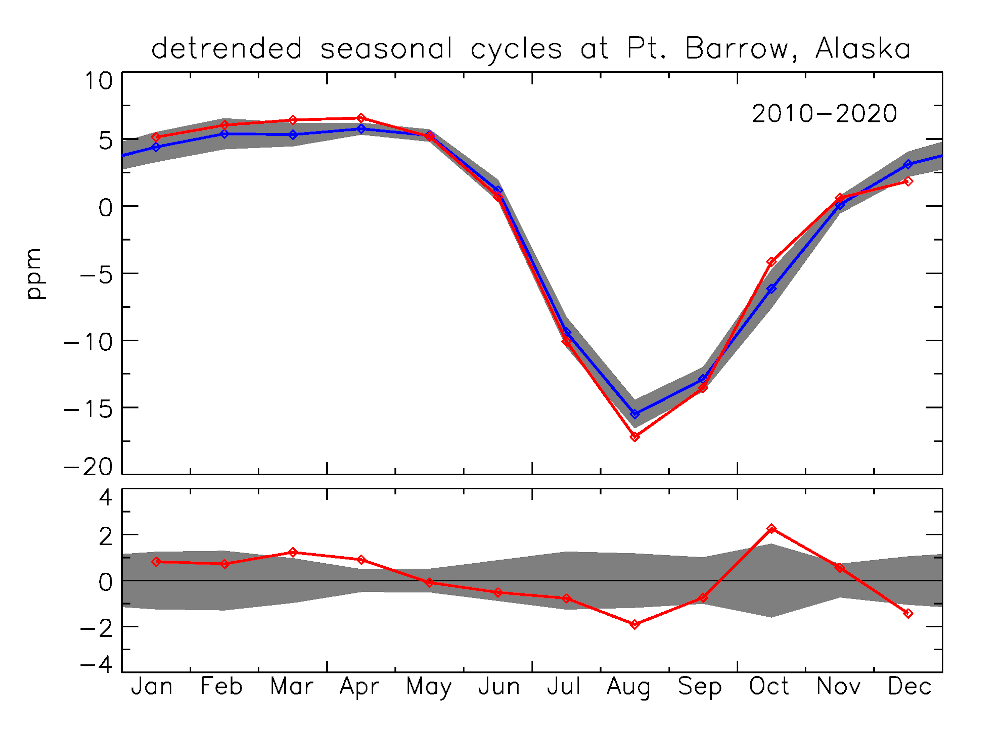Can we see a change in the CO2 record because of COVID-19?
We frequently are asked this question: CO2 emissions from the burning of fossil fuels are lower because of the pandemic, so why is atmospheric CO2 not also going down?
There is no photochemical destruction of atmospheric CO2 like there is for many other gases, methane for example in which case continuing emissions are required just to keep its abundance in the atmosphere constant. In contrast, atmospheric CO2 can dissolve in water and it can be turned through photosynthesis in plants into wood and other organic matter. However, these transfers are not permanent because the carbon can, and in fact does, come back again as CO2. In the oceans an equilibrium develops in which as much CO2 leaves the oceans as enters it. In plants and soils a steady state develops in which the rate of photosynthesis equals the rate of oxidation of carbon back to CO2 through respiration by living organisms and by fires. We ourselves are a part of that process as we exhale in our breath high levels of CO2. It has been produced in our cells, and in our intestines by microbes digesting food that gives us the energy needed to live. We also burn forests. The atmosphere, oceans, and terrestrial biosphere act like one interconnected reservoir from which the carbon does not disappear in any practical sense. Only rock weathering and formation can do that, but those are tiny trickles in comparison. Therefore, CO2 from fossil fuel burning can only increase the total carbon amount in this reservoir.
For us to be able to detect the drop in emissions caused by the pandemic it needs to be large enough to stand out from natural CO2 variability caused by how plants and soils respond to seasonal and annual variations of temperature, humidity, soil moisture, etc. CO2 increases everywhere in the atmosphere but super-imposed on that are seasonal cycles. After removal of the long-term increasing trend at each site one is left with a seasonal cycle caused primarily by seasonal photosynthesis and respiration of ecosystems on land. The three figures below show the 10-year average seasonal cycle, and the year-to-year variations. These natural variations are large, and so far the "missing" emissions from fossil fuel burning have not stood out. Here is an example: If emissions are lower by as much as 25%, then we would expect the monthly mean CO2 for March at Mauna Loa to be lowered by about 0.2 ppm, and again in April by another 0.2 ppm, etc. Thus, when we compare the average seasonal cycle of many years we would expect a difference to accumulate during 2020 after a number of months. The International Energy Agency expects global CO2 emissions to drop by 8% this year. Clearly, we cannot see a global effect like that in less than a year. In addition, the fires are producing CO2 at perhaps a similar rate as the modest lowering of emissions resulting from the pandemic. It does look like CO2 continues to increase at the same rate as in previous years, which illustrates that we need to make aggressive investments in renewable energy sources to tackle our global heating emergency.
Most of the emissions come from urban areas, so that it may be easier to see lowered emissions downwind of cities, although also in that case they need to stand out from natural variations. But there is a solution, the only decisive one. Cosmic rays produce radioactive carbon-14 (14C) in the atmosphere, which reacts with oxygen to become 14CO2. In that form it dissolves in the oceans and is taken up by plants like all the other CO2. Fossil fuels have no 14C because they were formed millions of years ago from organic matter. Thus, the 14C originally present in organic matter has long ago decayed. Therefore, measurements of 14CO2 in the atmosphere show how much the 14C has been diluted by the addition of recent fossil CO2 with zero 14C. On the other hand, CO2 from emissions and removals by ecosystems have very nearly the same 14CO2 content and thus cannot change the atmosphere in this respect.
East Coast Outflow COVID-19
In April 2020, the Global Monitoring Laboratory launched a series of aerial sampling flights over major East Coast metropolitan areas, repeating an experiment conducted two years ago, to assess the impact of coronavirus response on air quality and greenhouse gas emissions.

East Coast Outflow COVID-19 replicates a series of flights in 2018 encircling the cities of Washington, D.C., Baltimore, MD, Philadelphia, PA, New York, NY, and Boston, MA, to measure levels of methane, carbon dioxide, carbon monoxide, ethane and ozone upwind and downwind of these urban areas. Methane and carbon dioxide are the two of the most important greenhouse gases produced from urban centers, while carbon monoxide is a precursor to ground-level ozone, a primary concern for urban air quality.
The goal of this repeat study was to see what has changed in emissions of greenhouse gases and pollutants that form since the onset of COVID-19.
So far, NOAA contractors and collaborators have completed ten flights around New York City, four flights around the Washington and Baltimore areas, and four flights around the Providence and Boston areas.
Funding for the flights has been provided by NOAA, the state of Maryland and the National Institute of Standards.
Scientists from NOAA’s Chemical Sciences and Air Resources laboratories are also participating in the experiment as well as researchers from the University of Michigan, Columbia University, University of Maryland and SUNY Stonybrook.
Follow atmospheric CO2 levels on our Trends page



